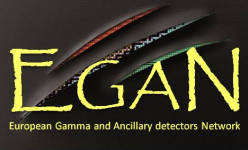Speaker
Akis Pipidis
(INFN, Laboratori Nazionali di Legnaro, Legnaro (Padova), Italy)
Description
In nuclear-structure physics, especially while exploring unknown regions of the chart of nuclides, the experimenter needs to carefully address the identification of the products from nuclear reactions. The reaction channel selectivity can
be achieved through the detection of all, or at least as many as possible, of the emitted light particles (mainly neutrons, protons, and/or α particles). However, since the neutrons are more challenging to deal with, a clean and efficient detection of the number of emitted neutrons in each reaction is a critical matter. To this end, a new, neutron-detector array (NEDA) has been realized, based on the previous knowledge acquired by its predecessor (the Neutron Wall). NEDA will be made of a large number of closely-packed liquid-scintillator detectors suitable for detection of neutrons, in the energy range 0.1−20 MeV. NEDA will be coupled to γ-ray germanium arrays such as AGATA, EXOGAM2, and GALILEO for γ-ray spectroscopic studies. The goal is to design and build an array with the highest possible neutron detection efficiency, excellent discrimination of neutrons and γ rays, and a very small neutron-scattering probability. At LNL-INFN, we have been testing two types of prototype detectors. The first type involves detectors with the traditional BC501A scintillator liquid, whereas the second type consists of detectors made of the deuterated scintillator liquid BC537. Procatarctic results regarding the performances of these detectors will be presented.
Primary author
Akis Pipidis
(INFN, Laboratori Nazionali di Legnaro, Legnaro (Padova), Italy)
Co-authors
Dr
A. Di Nitto
(INFN and Dipartimento di Scienze Fisiche dell'Universita di Napoli, Napoli, Italy)
Dr
A. Gadea
(IFIC-CSIC, Universitat de Valencia, Valencia, Spain)
Prof.
G. De Angelis
(INFN, Laboratori Nazionali di Legnaro, Legnaro (Padova), Italy)
Mr
G. Jaworski
(Heavy Ion Laboratory, University of Warsaw, Warszawa, Poland and Faculty of Physics, Warsaw University of Technology, Warszawa, Poland)
Prof.
G. La Rana
(INFN and Dipartimento di Scienze Fisiche dell'Universita di Napoli, Napoli, Italy)
Mr
J. Agramunt
(IFIC-CSIC, Universitat de Valencia, Valencia, Spain)
Dr
J. J. Valiente-Dobon
(INFN, Laboratori Nazionali di Legnaro, Legnaro (Padova), Italy)
Prof.
J. L. Tain
(IFIC-CSIC, Universitat de Valencia, Valencia, Spain)
Prof.
J. Nyberg
(Department of Physics and Astronomy, Uppsala University, Uppsala, Sweden)
Prof.
M. N. Erduran
(Department of Physics, Istanbul University, Istanbul, Turkey)
Dr
M. Palacz
(Faculty of Physics, Warsaw University of Technology, Warszawa, Poland)
Mr
P.-A. Soderstrom
(Department of Physics and Astronomy, Uppsala University, Uppsala, Sweden)
Prof.
R. Wadsworth
(Department of Physics, University of York, Heslington (York), United Kingdom)
Prof.
S. Erturk
(Nigde Universitesi, Fen-Edebiyat Falkultesi, Fizik Bolumu, Nigde, Turkey)
Mr
T. Huyuk
(IFIC-CSIC, Universitat de Valencia, Valencia, Spain)

